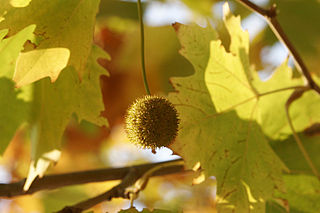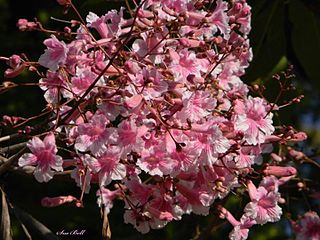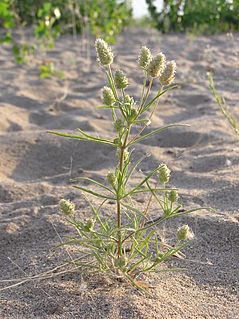
In botany, a bud is an undeveloped or embryonic shoot and normally occurs in the axil of a leaf or at the tip of a stem. Once formed, a bud may remain for some time in a dormant condition, or it may form a shoot immediately. Buds may be specialized to develop flowers or short shoots or may have the potential for general shoot development. The term bud is also used in zoology, where it refers to an outgrowth from the body which can develop into a new individual.

An inflorescence is a group or cluster of flowers arranged on a stem that is composed of a main branch or a complicated arrangement of branches. Morphologically, it is the modified part of the shoot of seed plants where flowers are formed. The modifications can involve the length and the nature of the internodes and the phyllotaxis, as well as variations in the proportions, compressions, swellings, adnations, connations and reduction of main and secondary axes. One can also define an inflorescence as the reproductive portion of a plant that bears a cluster of flowers in a specific pattern.

Platanaceae, the "plane-tree family", is a family of flowering plants belonging to the order Proteales. The family consists of only a single extant genus Platanus, with eight known species. The plants are tall trees, native to temperate and subtropical regions of the Northern Hemisphere. The hybrid London plane is widely planted in cities worldwide.

Trichomes, from the Greek τρίχωμα (trichōma) meaning "hair", are fine outgrowths or appendages on plants, algae, lichens, and certain protists. They are of diverse structure and function. Examples are hairs, glandular hairs, scales, and papillae. A covering of any kind of hair on a plant is an indumentum, and the surface bearing them is said to be pubescent.

Cosmos bipinnatus, commonly called the garden cosmos or Mexican aster, is a medium-sized flowering herbaceous plant in the daisy family Asteraceae, native to the Americas. The species and its varieties and cultivars are popular as ornamental plants in temperate climate gardens.

Lithospermum canescens, or the hoary puccoon is a perennial herb endemic to eastern North America. The plant is a perennial herb that has golden yellow flowers which bloom from April to May.
Plectocomiopsis is a dioecious genus of flowering plant in the palm family found in Indochina, Malaysia, Borneo and Sumatra. Hapaxanthic and armed with spines, they are a climbing rattan, closely related to the Myrialepis palms. The name is Greek for "similar to Plectocomia", another close relative.
This glossary of botanical terms is a list of definitions of terms and concepts relevant to botany and plants in general. Terms of plant morphology are included here as well as at the more specific Glossary of plant morphology and Glossary of leaf morphology. For other related terms, see Glossary of phytopathology and List of Latin and Greek words commonly used in systematic names.

In plant morphology, thorns, spines, and prickles, and in general spinose structures, are hard, rigid extensions or modifications of leaves, roots, stems or buds with sharp, stiff ends, and generally serve the same function: physically deterring animals from eating the plant material.

Phacelia greenei is a species of phacelia known by the common name Scott Valley phacelia. It is endemic to the southern Klamath Mountains of far northern California, where it is known only from Scott Valley, a valley known for its alfalfa growing, and vicinity.

Brunfelsia latifolia, commonly known as yesterday-today-tomorrow and kiss me quick, is a species of flowering plant in the nightshade family. Endemic to Brazil, it is an evergreen shrub that becomes semi-deciduous in cooler areas and grows up to 1.8 meters in height.
Drosera peruensis is a carnivorous plant of the genus Drosera, commonly known as the Peruvian sundew. This Drosera species was first identified in Peru in 2002 by Tânia Regina dos Santos Silva and Mireya D. Correa following work to update the genus Drosera for the reference text, Flora Neotropica..

Astianthus is a monotypic genus of flowering plants in the Bignoniaceae family. The sole species is Astianthus viminalis. It is known by the common names achuchil in Mexico and chilca in Guatemala and Honduras.

Stereospermum kunthianum is an African deciduous shrub or small tree occurring in the Democratic Republic of Congo, Djibouti, Eritrea, Ethiopia, Kenya, Malawi, Senegal, Somalia, Sudan, Tanzania and Uganda. It is widespread across Africa to the Red Sea, and reaches as far south as Angola, Mozambique, Zambia and Zimbabwe. There are some 30 species with a Central African and Asian distribution.

Persoonia saccata, commonly known as snottygobble, and cadgeegurrup in indigenous language, is a plant in the family Proteaceae and is endemic to the south-west of Western Australia. It is usually an erect shrub and has linear leaves and groups of up to fifty or more irregularly shaped, yellow flowers which are hairy on the outside. It usually grows in woodland dominated by jarrah, marri or large Banksia species.

Hypericum aegypticum is a species of flowering plant of the St. John's Wort family (Hypericaceae) which is native to coastal Mediterranean regions. It was described by Carl Linnaeus in his Species Plantarum in 1753, and the specific epithet he gave it means "from Egypt". In English, the plant is known as Shrubby St. John's Wort or Egyptian St. John's Wort. A shrub or shrublet of varying heights, the species can be found among limestone rocks in coastal Mediterranean regions. The species is notable for its heterostyly, a trait which within the Hypericum genus is unique to section Adenotrias.

Plantago indica, commonly known as branched plantain, sand plantain, or black psyllium, is a flowering plant in the plantain family Plantaginaceae, and is one of a few species in the Plantago genus under the common name psyllium. The plant is native to parts of Africa, Europe, Russia, and Asia, and has been naturalized in many other areas such as Australia and North America. The plant can be found mostly in dry inland areas, such as those that are sandy, and has also naturalized on roadsides and in meadows. The plant is not used broadly as a food source, but has been cultivated for its seeds which serve a medicinal use as a laxative.

Heterophragma is a genus of two species of tree, constituting part of the plant family Bignoniaceae. The species are found in Southeast Asia and India.

Hypericum elodeoides, commonly called the Himalayan St. John's Wort, is a species of flowering plant of the St. John's wort family (Hypericaceae).
Silphium perplexum is a prairie species in the family Asteraceae, it is endemic to the state of Alabama. S. perplexum is commonly known as Old Cahaba rosinweed, a reference to the Cahaba River near which all populations of this species are found.















